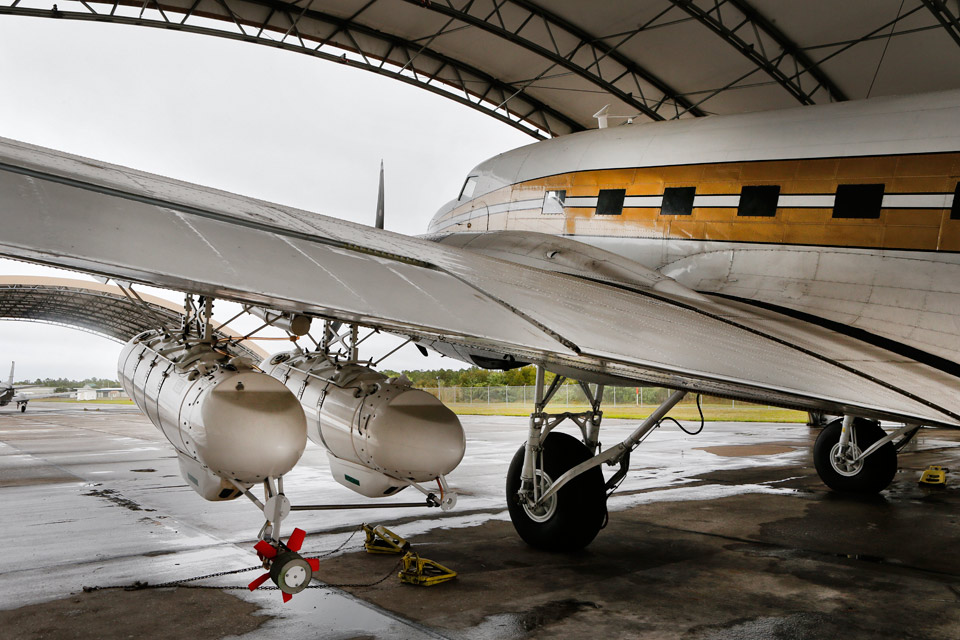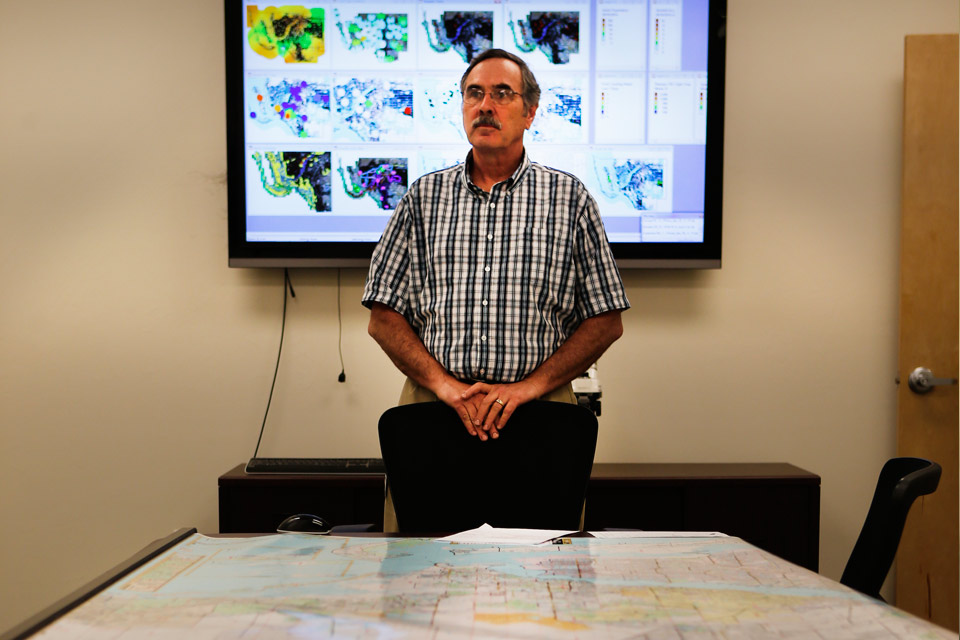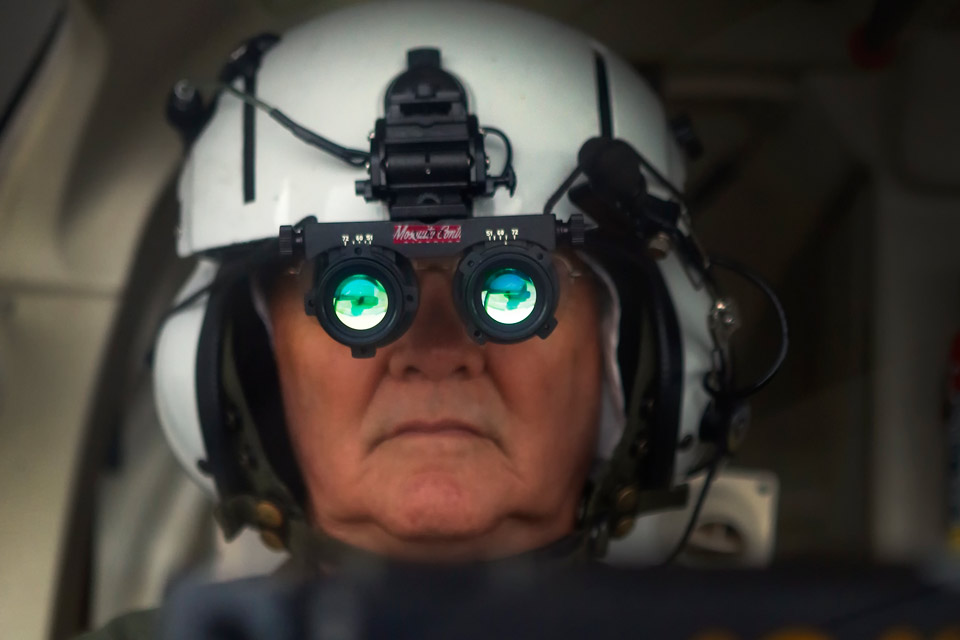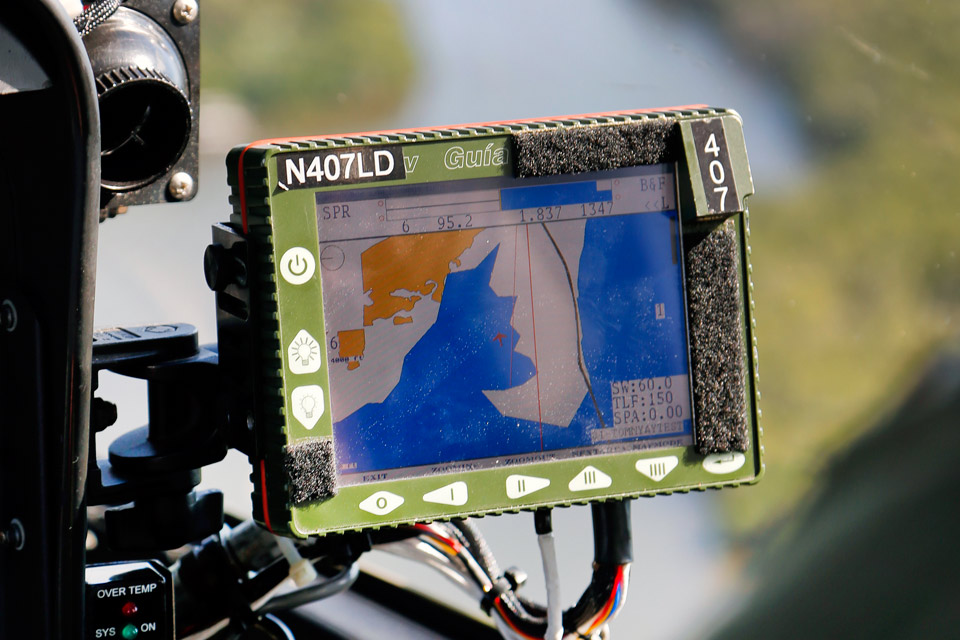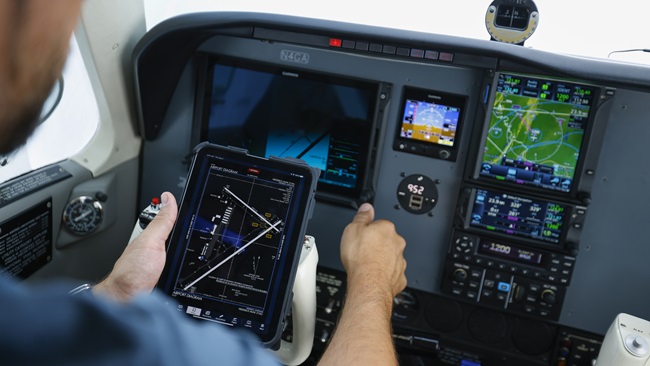There’s a war going on in South Florida. An army of highly skilled aviators is flying battle-ready helicopters and airplanes at all hours of the day and night, supported by a team of engineers. They’re all working to combat a worthy foe—the mosquito. Mosquito netting, quinine water, smoke oil belched from trucks—you name it, they tried it. It was not until the mid-1950s that an engineer named T. Wayne Miller unified the Lee County Mosquito Control District (LCMCD). First, his group discovered which bugs carried disease (called the “vector”). Then they learned where the critters laid eggs, how the bugs matured, and when and where they flew. Finally, researchers realized that the best method for killing adults was to hit the mosquitos with a chemical mist while they flew. Aerial application was the best way to make that happen.
Only the military-surplus Douglas C–47s Miller astutely acquired for the county could efficiently cover a 1,000-square-mile area with Diabrom (Malathion was used in the past)—often flying as flights of two or three aircraft. You could feel the difference almost immediately after the bug bombers receded into the distance. While Miller knew that aerial application of adulticide chemicals (killing adult mosquitos) was improving life for Florida residents, there had to be more effective ways of eliminating the menace. Reducing standing water where people lived had, until then, been the population’s best defense—but on a peninsula defined by its natural swamps, mangrove shallows, and saltwater flats, one can only reduce so much. Data from the LCMCD research labs suggested that interrupting the lifecycle of the mosquito held potential.
Today, mosquito larvae are treated with methoprene, a hormone that causes the adult mosquito to fail to emerge from pupae. It is applied by helicopters (JetRangers, Hueys, and Bell 407s) and can provide 12 to 15 weeks of relief from mosquitos—but that rarely happens in South Florida. Not all eggs hatch at once, so larvaciding may kill only a quarter of a brood, or less. It is common for LCMCD pilots to stay busy reapplying the hormone several times between May and October to keep mosquitos down.
In the district’s laboratory several species of mosquito larvae are grown in controlled conditions and subject to varying quantities of the hormone at different points in their development. “We are constantly changing up formulas to keep the mosquitos from becoming resistant,” explained Shelly Redovan, deputy director of education and communications for LCMCD. In another screened area are adult mosquitos, also subject to chemical experimentation.
Not all mosquitos are disease carriers, Redovan noted. “We are careful to leave larvae in the mangrove fish hatcheries,” she explained, pointing out that juvenile grouper, snapper, and snook rely on them for food. Frogs, spiders, and dragonflies also eat mosquitos. “There’s a balance to the ecosystem that has to be maintained. For that reason, we can’t spray certain state or federal land at all.”
As a result, the county is pockmarked with parcels off-limits to larvaciding and adulticiding, creating real challenge for aerial applicators. New in-cockpit hardware and software, as well as innovative spray technology and guidance developed by AG-Nav and LCMCD in the past decade, have made spraying with near-pinpoint accuracy a reality.
Across the hall from the warm, moist growing area is a meticulously clean, icy cold lab where biotechnician Milton Sterling processes blood drawn from the county’s 17 flocks of sentinel chickens. “Birds get bit by mosquitos, too. We keep these birds throughout the county,” he said. “Each week the pilots take technicians out to the birds to draw blood from the chickens and bring it back here. I process it to see if I can find antibodies to our known problem diseases.” Sterling searches for distinct RNA strands that indicate disease exposure; if it does, he checks in with both the local health department and the Centers for Disease Control and Prevention in Atlanta, where the hunt begins for patient zero.
“Some of those who get sick were actually bitten and infected outside of Florida, but when they travel here and are bitten by our mosquitos, the diseases spreads,” Sterling said. Chikungunya and Dengue are two diseases that require a human-to-mosquito-to-human connection. They are carried by Aedes aegypti and Aedes albopictus, both of which live in south Florida.
When the helicopters aren’t spraying or making chicken runs to collect blood, they are carrying inspectors to known mosquito “holes” where they can dip their white inspection ladles into the swampy shallows and do quick counts that help establish both when methoprene application is required, and when it might be too late.
“If the hatch is about to go off, then it is time to get the aircraft loaded with Diabrom and call ARTCC to let them know we’ll be adulticiding at night,” said Rick O’Neal, chief pilot for LCMCD. The call is a courtesy; ARTCC assigns the bug bombers a discrete squawk code and stands ready in case 911 dispatchers call to ask if they are spraying. “People new to the county often call 911 when they see the DC–3s, because we fly so low—they think we are about to crash,” he chuckled.
LCMCD’s fleet of aerial applicators today bears a slight resemblance to the thunderous bug bombers of the past. For one, the C–47s and their burly radial engines are gone. They were replaced more than a decade ago with Dodson International Turbo Dakota DC–3TPs, with twin 1,230-shaft-horsepower PT-6A-65AR turbines turning whisper-quiet Hartzell five-blade, fully reversible propellers. As reliable as they have been, a trio of Beech King Airs slated to replace the -3s sit in LCMCD’s hangars. The newer aircraft feature machined-on-site external belly tanks and ultra-low-pressure spray systems capable of producing the tiny 25-micron Diabrom droplets required to kill adult mosquitos.
The Dodson -3s have integral chemical tanks positioned aft, but they’ve been retrofitted with wing-mounted pods, completely external (Diabrom is extremely corrosive—you don’t want it on your airplane or your skin). The new dispersion system requires no in-flight pilot intervention, thanks to LCMCD pilot and resident inventor Gene Sutton. About a decade ago Sutton pushed hard for adaptation of the AG-Nav graphical mapping interface into LCMCD aircraft. He and Lai Nguyen, chief technologist for AG-Nav, wrote and rewrote the box’s Linux-based software and designed the interface to the spray and granular dispersion hardware. There was a lot of trial and error. Ultimately, the system was refined to its current rendition, and all that testing gave birth to a state-of-the-art aerial application system.
Larvae inspectors can order a flight, but most complaints come from homeowners. A truck drives the prescribed area at night and collects a sampling of mosquitos that are counted, sexed, and segregated by species. If the count supports the complaint, an adulticide night run is scheduled. The scientist defines the areas to be sprayed using polygons drawn over Google Earth. The program takes forecast wind into consideration and calculates the chemical drift, too.
The pilots arrive and open the polygon files on their flight-planning computers. They refine the plan, linking adjacent spray areas into one large spray area (long runs are preferred), then set up waypoints to the initial spray box and beyond. All is downloaded to a USB key, then uploaded into the aircraft AG-Nav GUIA guidance system, which provides moving-map navigation and obstacle awareness to and from the spray sites. It also switches on the autospray, and guides the pilot along each row with a light bar that is accurate to within a few feet.
“I don’t know that the GUIA makes it any easier to fly a straight line, but it certainly makes it easier to verify that you didn’t fly a straight line!” O’Neal said.
The autospray is integral to the system, turning off the spray at the end of each row and restarting it at the beginning of the next row. Get too far off a row or out of the spray box? The autospray shuts off, protecting no-spray zones. Need to exclude an area in the middle of your spray box? Autospray will take care of that, too. New software even corrolates the volume of application to aircraft groundspeed.
The result is reduced pilot workload. “They can focus on flying and accuracy now, and it shows,” O’Neal said. “Our tracking is downloaded at the end of each mission, for the scientists and administrators. Now we can see better how accurately we have applied the chemicals and then compare that to the kill.”
Flying at low altitude in the -3s no longer holds quite the risk it used to a decade ago, either. Today the pilots fly an oval racetrack pattern and follow a cockpit-mounted light bar to intercept and track each run. The GUIA jumps to every seventh row, allowing wide and gentle turns at each row end; the GUIA is followed until the polygon shows it’s completely sprayed. (Helicopter pilots, who often spray on day runs, still get to do their signature steep, sliding turns and fly row by row at 75 feet agl—woo hoo!)
The NVGs are another safety enhancement. “Those took some getting used to,” said Lee Reed, senior pilot. “With the counterweight on the back of your helmet and the NVGs clipped up front the system was heavy, and that weight was fatiguing until your neck muscles strengthened up.” The devices concentrate visible light and magnify its power by 6,000 percent, then project the images onto a green phosphor screen that is viewed through goggle-like lenses.
“I love what the NVGs do for the safety of the flight,” said Rita Maiss, a former Army helicopter pilot who has been with LCMCD since 2011. “This is extremely high risk, as close as we come to mother Earth without hitting anything. Anything that increases safety in the operation is welcome,” she said.
The NVGs require the pilots to fly at 350 feet; that’s 50 feet higher than they had been flying, and significantly higher than the old bug bombers used to fly. The height increase alone means they have a 42-percent lower chance of hitting one of the numerous towers or power lines that prickle the peninsula.
A disadvantage of the NVGs is that they don’t “see” LED lighting well, which was a problem until LCMCD petitioned to have highly visible reflective tape added to every tower in Lee County. Now towers literally glow in the dark when hit with special belly lights each LCMCD aircraft carries.
To keep up, LCMCD pilots train constantly. O’Neal figures there have been years during the transition to the AG-Nav system and the NVGs where the district’s training flight hours outnumbered actual application flight hours. He’s not worried about it, though. “Those chemicals are expensive, and if you waste them, that is wasted taxpayer dollars,” he said. “Worse, you could misapply them and they’d be dangerous. So spending the time training and learning how to fly the aircraft properly, and the ground school hours spent studying the GUIA, are justified.”
“It takes so much practice to fly like this—you look out at the line, find an object on the horizon to track with, then inside at the light bar, scanning in and out as you fly the line,” Reed explained. “It depends on the pilot’s experience as to how easy it is to teach them.”
It takes 100 hours of applicator experience and three challenging written exams to earn an aerial applicator permit in Florida (each state has its own requirements, and not all states offer reciprocity). Pilots need to understand the toxicity of the chemicals they carry, and exercise exceptional judgment at all times. The flight department also cross-trains all its pilots, so helicopter pilots become fixed-wing pilots and vice versa. This maximizes the relatively small department’s flexibility—and is part of the job’s appeal.
Often, pilots are brought on part-time to see if they’ll work out before the district commits to training them further.
Pilot Mike Vigus was flying for mosquito control in Jacksonville, Florida, but after attending the Florida Mosquito Control Association’s annual educational meeting in Lee County he set his sights on a job there. A former Army helicopter mechanic and fixed-wing pilot, he has been cross-trained to fly the helicopters and is the newest DC–3 type-rate pilot in the department.
“About half our pilots were Army aviators at one point,” said O’Neal. A few, such as Reed, have come up through the civilian ranks, although most of these have aerial application experience in their logbooks before being hired by LCMCD.
At some point in the distant future, the spraying may be seceded to autonomous drones—maybe when surplus Predators become available. Until then, the pilots and LCMCD staff are heroes to county residents—even those who aren’t aware they’re up there.
Amy Laboda is a freelance writer living in southwest Florida.
Photography by Chris Rose
Extra: View the video




